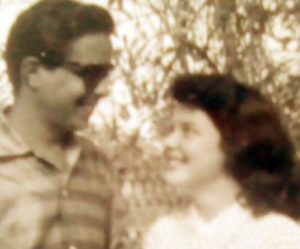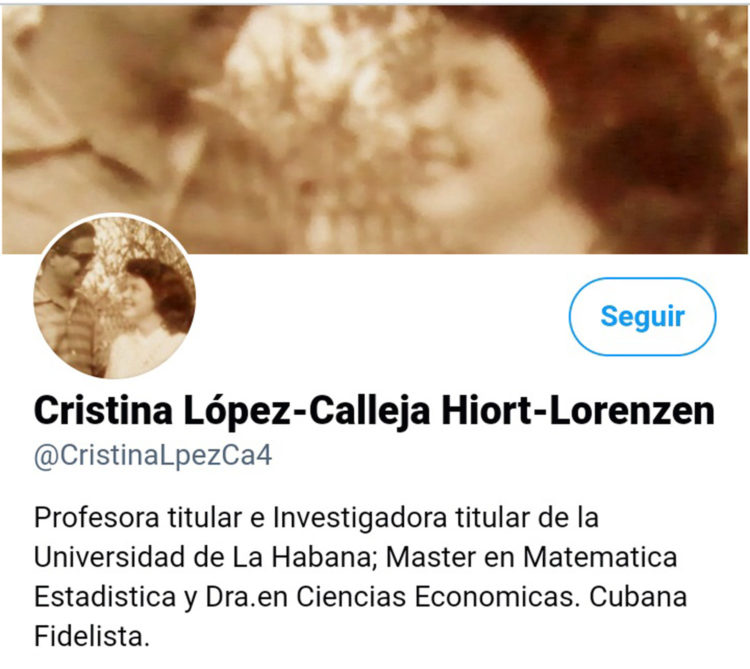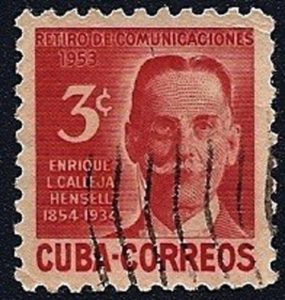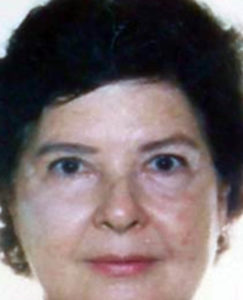HAVANA, Cuba. – If there is an individual in Cuba who knows about migratory flux, about how the migration phenomenon works among various age and social groups, places of birth, and even make statistical predictions on these matters, that individual is Cristina López-Calleja Hiort-Lorenzen, a full professor who holds a Ph.D. in Economic Sciences from the Center for the Study of International Migrations of the University of Havana.
Her colleagues regard her as the indisputable authority on the subject, bar none, from the 1980s until today, and proof of this in how often she is quoted in papers written by other well-known Cuban and foreign research scholars. Add to that dozens of awards and medals the Cuban regime has bestowed on her for her services, most recently in 2018.
“Nobody handles more information about migrations than she and her personal team do. Nobody else has been given access to secret documentation. I could say that not even a specialist from the National Office of Statistics and Information (ONEI, by its Spanish acronym) knows more than Dr. Cristina about the subject matter,” states a colleague interviewed by CubaNet on condition of anonymity for fear the regime would punish him with losing his employment, or even with jail.
His testimony is no exaggeration. Other sources who at one time or another had direct links with this expert’s job have confirmed it to us. The most confidential files of the Foreign Ministry (MINREX, by its Spanish acronym) to which all Cuban consular offices and embassies around the world report, have been available to her, long before Foreign Minister Roberto Robaina –who was demoted in 1999 – launched in the nineties his political strategy of reaching out to Cuban emigres. His hidden agenda was eminently economic in spite of being promoted as a “reconciliation gesture” by the regime.
The conferences under the heading “Nation and Exile” (La nación y la emigración) began in Havana in April 1994, and in the opinion of several former MINREX officials that CubaNet consulted, their hidden objective was to attract both capital and political support from what the regime considered the moderate sectors of the exile community.
One year before, in 1993, Fidel Castro had named to the post of foreign minister the young Robaina, probably with the intention of projecting a renewed image of his government on the international front. Foreign investments for tourism had arrived; his plan to build hundreds of hotels required great amounts of capital and to achieve that he would not hesitate in encouraging receipt of remittances, and more: he would reinforce influential groups abroad, officially known as “groups of solidarity with Cuba,” to make everyone believe that the island was starting an “opening period”.
With the demise of communism in Eastern Europe, and the end of economic subsidies from the Soviets, the Cuban economy sank into the worst crisis in its history. Cuba’s Gross Domestic Product (GDP) decreased by almost 35%, fuel shortage paralyzed the country, and general discontent almost resulted in a popular revolt that could have toppled Fidel Castro’s dictatorship.
As shrewd as he was wicked, Fidel Castro found a solution to his domestic problems once more, by activating his most reliable escape valve: allowing a massive exodus.
Not only was Castro ridding himself of disaffected Cubans and infiltrating amongst them spies that he could lodge in the heart of “the enemy”, but also, he would be revitalizing the exile community with “new blood” assuring himself of fresh remittance sources for another decade.
As a result, he blamed the U.S. government for the street riots in the island, opened the maritime borders by suspending Cuban Coast Guard surveillance, and allowed thousands of Cubans to take to the seas, without regard for the risks that the 90-mile crossing between Cuba and Florida meant to those fleeing on makeshift crafts.
In the eighties, with Democrat Jimmy Carter in the White House and the official negotiations with the exile community underway, Fidel Castro had done something similar. The events at Peru’s embassy in Havana gave him the excuse to stage another exodus at the precise moment when relations with the U.S. were most relaxed and exiles had started to return to visit the island and to send financial assistance to their families after 20 years of separation and broken communications.
In November 1978, prior to the Mariel exodus, initial conversations with “moderate exiles” had begun; they were arranged by the Foreign Ministry and the Center for Demographic Studies at the University of Havana, which was founded in 1972. That was, also, when the Center for the Study of International Migration (CEMI, by its Spanish acronym) was started, as well as the genesis of the Foreign Ministry’s Office of Consular Affairs and Attention to Cubans Residing Abroad (DACCRE, by its Spanish acronym).
Cristina Lopez-Calleja Hiort-Lorenzen, Mister GAESA’s mother
Only a most trusted individual could have been charged with the responsibility of a subject as important as the detailed and scientifically precise study of the various components of the Cuban exile community. It had to be someone intelligent enough and capable enough to analyze and process all possible variables and that, at the same time, would guarantee discretion and loyalty above all.
That was Cristina Lopez-Calleja Hiort-Lorenzen, a specialist in statistical mathematics, with sound knowledge of economics and probability calculations, and, above everything else, the wife of one of the military subjects most loyal to Fidel Castro: Division General Guillermo Rodríguez del Pozo (1929-2016). A former 26 of July Movement combatant in Santa Clara and chief of the Revolutionary Armed Forces (FAR) Medical Services since 1968, General del Pozo was named Raúl Castro’s Substitute Armed Forces Minister in 1982.

From the marriage of Guillermo and Cristina, several children were born, among them Luis Alberto Rodriguez Lopez-Calleja in 1960, who is considered today the most powerful man in Cuba, not only because he heads the most important business and financial conglomerate of the regime -the Armed Forces’ GAESA- but also because of his personal relationship with Raúl Castro. These are the two reasons that undoubtedly have determined his rise to the Politburo of the Cuban Communist Party as trustee of the Castro clan’s fortune.
However, when Fidel Castro named Cristina Lopez-Calleja as head of the “Cuban exile community” research team, Luis Alberto was just a teenager. Although he was a neighbor of Raúl Castro whom he visited sporadically in the company of his parents, back then Luis Alberto didn’t even dream of one day marrying Deborah Castro Espin, nor of studying in Russia or graduating Summa Cum Laude so far away from home with a degree in Business Administration, nor of eventually ending up –due to the undeniable talent for numbers that he inherited from his mother- as the protégé of Division General Julio Casas Regueiro, chief of the Armed Forces’ Economic Department and the actual creator of GAESA.
When Luis Alberto Rodriguez Lopez-Calleja married Deborah Castro Espin in the eighties, his mother Cristina had long been making of migration her main field of study, and Fidel Castro was taking into consideration her regular reports about outreach strategies toward given exile “groups of interest,” especially those living in the United States and Europe.
“At first it was all about penetrating enemy organizations, but later, in the nighties, everything became about economics,” according to a former Cuban diplomat who spoke to us on condition of anonymity for fear of reprisals, even though he has not resided in Cuba for over a decade.
He goes on: “It was the period when many businesses were set up in Europe and even in the United States (…), not only in offshore tax havens (…), mostly shipping companies, freight forwarding, asset purchases; and in the United States, Mexico and Canada as well (…), travel agencies, charter-flight companies, replacement parts, that type of thing (…). Almost every type of exile group was studied, and profiles were drawn up to easily identify later on the “who and how” of collaborations both here (in Spain) and in the U.S. The study of groups in the U.S. broke them down into groups: those in Florida, New Jersey, Chicago, those in colleges and universities (…). Where were the exiles in the sixties, in the seventies and eighties, what relatives they had left behind in Cuba, what universities their children and their children’s children attended, just everything.” Our source served in a diplomatic capacity from the late seventies to the mid-nineties in several European cities.
Proof of these specific interests is the research paper titled “Potential and Effective International Migrations in Cuba” (in Spanish, “Las migraciones internacionales potenciales y efectivas en Cuba”).
Presented by Cristina herself at the third congress of the Latin American Association on Population (ALAP, by its Spanish acronym), held in Argentina in 2008, the detailed study is based on the National Survey of Domestic Migrations, conducted under the auspices of the Cuban government. The survey asked the population about its desire to migrate to another country. Individuals surveyed were typified by their socio-demographic attributes.
In her Introduction, Cristina wrote that “starting with the cross-referencing of data, we proceeded to analyze the existence of a relationship between domestic migration and the potential for migration abroad. We studied the potential migrants,” and in this manner groups were established and “we analyzed the conduct of external migration from 1959 until 2007, proving that its net increase had been reduced and the negative migratory balance had increased.”
Regardless, the objective of Cristina Lopez-Calleja’s presence in the 2008 event in Argentina was strictly political: to mask the true causes of Cuban migration at a time when a transition of power in the island was occurring from Fidel Castro’s rule to that of his brother Raul. To that effect, the author concludes that ‘the majority of Cubans recognize the possibilities and advantages of socialism in spite of shortages and other difficulties, and remains loyal to the Revolution.” Nonetheless, the report allows us to see just how important the issue of migration is to the Cuban regime and why the Castros placed this issue in the hands of an individual within the close-knit family circle, as they have done with other sensitive issues such as foreign investment, health, tourism and even sexuality.
In her conclusion, Cristina Lopez-Calleja writes: “The subject of Cuban migration is manipulated by the enemies of the Cuban Revolution, which makes it an issue of national security.”
This means that, as she herself states, Cristina Lopez-Calleja Hiort-Lorenzen was turned into a migration authority for reasons of “national security”. Although curiously, in addition to her research on mathematical statistics, she is co-author of “Introduction to the Theory of Probabilities” (“Introducción a la teoría de las probabilidades”) published by Cuba’s Editorial Científico-Técnica in 2008, and “Methodology of the Teaching of Physics” (“Metodología de la enseñanza de la Física”) a secondary-school textbook, published by Cuba’s Editorial Pueblo y Educación in 1985.
In spite of her advanced age, today she is very active on Twitter, forwarding writings by Miguel Diaz-Canel Bermudez, Ramiro Valdes, the spy Gerardo Hernandez Nordelo, the attorney Eva Golinger and even Pope Francis. However, there are very few photographs of Cristina. Her social media accounts are not generous. In that regard, she has been more careful than her son Luis Alberto, whose face has been seen only in the last two years as he has assumed the vacuum left by his former father-in-law, Raul Castro.

Full Professor and Chief Researcher, University of Havana; Masters in Mathematical Statistics, and Ph.D. in Economic Sciences. Cuban citizen, and Fidel follower.
In her Twitter account, where she Introduces herself as Cuban and a follower of Fidel, Cristina was a bit more generous and included a photo from when she and her husband Guillermo Rodriguez del Pozo met in Santa Clara. He had graduated from medical school and she was finishing her studies in mathematics at Las Villas province’s Universidad Central “Marta Abreu”.
The other Lopez-Calleja
According to public records, Cristina Lopez-Calleja Hiort-Lorenzen is the daughter of Aristides Lopez-Calleja, an engineer from Cienfuegos who was born in 1903. Her mother’s name was Eva Frances Magdalene Hiort-Lorenzen, born in April 1907 to Jewish parents who had emigrated from Denmark and Poland.
From that marriage, other Lopez-Calleja Hiort-Lorenzens were born: Aristides Rodolfo, Magda, Arturo Edmundo, and Cristina in 1936, the youngest of the children. She is Luis Alberto Rodriguez Lopez-Calleja’s mother.
Luis Alberto and his father, General Guillermo Rodriguez del Pozo, are not the only ones in the family to occupy high posts in the island. During the early years of the Cuban Republic, Enrique Lopez-Calleja Hensell (1854-1934) was Minister of Communications. The Republic issued a 3-cents postage stamp in his honor in 1953.

The Lopez-Calleja family is huge and it is widespread around the world. There are Lopez- Calleja in Spain, Denmark, Italy, Greece, Turkey, Poland, Cyprus and Luxembourg. Some of them have never visited Cuba nor do they have contact with the two branches of the family that live in the United States. A Lopez-Calleja line was established in Europe before 1959; there is another line established much more recently, starting in the nineties. There is another, equally-segmented line, established in the U.S.
In order, perhaps, to distance themselves from the Lopez-Calleja who stayed in Cuba and are linked to the regime, another branch of the family migrated at the same time, and some took on the surname “Levy” (like Sara Levy Rodriguez, a Santa Clara-born pianist who left Cuba in 1958 and took her husband’s last name), or they merge the surname with “Lopez” and eliminated “Calleja” to shorten it, or as in better known cases (like that of Arturo Lopez-Levy, who graduated from Cuba’s Institute of International Relations and at present is a professor of U.S. universities), to establish clearly that distancing. However, nothing can be affirmed solidly about their true intentions, because the majority travels frequently to Cuba and keep in touch with each other and with the Oltuskis, another family that is very tight with the Castro regime and equally related to the Lopez Calleja through General Rodriguez del Pozo.

Photo of Mariana Oltuski, in Madrid, 2018. (Source: social media)
Luis Alberto’s sister, Isabel Cristina Rodriguez Lopez-Calleja, was the last one to emigrate just two years ago. Her two children, Ana Cristina and Juan Carlos, settled in Miami a decade ago; their father, Dr. Juan Carlos Sarol, a physician, filed their claim with U.S. immigration authorities. Dr. Sarol was director of gastroenterology at Hermanos Ameijeiras Hospital in Havana between 1992 and 2000.
Dr. Sarol first emigrated to San Jose, Cost Rica, where he was hired as physician in January 2000. In 2005, he moved to Puerto Rico, acquired U.S. residence, and in 2007 settled in Orlando, Florida to complete his medical residence at the Regional Medical Center, which he did in 2009. In 2016, he finished his postdoctoral specialty in endoscopy and gastroenterology at Larkin Community Hospital, where he has been a consulting physician since 2013.

of Luis Alberto Rodriguez Lopez-Calleja. Today, he resides in the U.S. (Photo from social media)
His daughter, Ana Cristina (known in social media as Christa Anne Mumford) is a pharmaceutical specialist. His son, Juan Carlos Sarol, is listed as director of two small firms recently registered in Florida: Flohomes Roofing, a home repair company registered in April 2020, and a small finance and real-estate company, AGS Property Solutions, registered in August of the same year.
Among the Lopez-Calleja that migrated to Europe is Arturo Edmundo Lopez-Calleja Hiort-Lorenzen, maternal uncle of GAESA’s president. Connected to the Cuban Ministry of Education and professor at CUJAE (Technological University of Havana “Jose Antonio Echeverria”), he served on a mission in Angola between 1977 and 1978. During one of his trips in 2011, as purchasing agent of the Cuban government, he decided to stay in Spain, where he now resides in Asturias.

Another descendant, Javier Lopez-Calleja, today lives in Fort Lauderdale in the U.S. He studied mechanical engineering at the Cuban Naval Academy in the eighties, and worked for the Cuban Fishing Fleet until 1993, the year he decided not to return to the island.
Of the family members that remain in Cuba, most are either directors of hotels (the commercial director of the Kohly Hotel is Diana Rabassa Lopez-Calleja, while the vice president of Gaviota S.A. is Frank Oltuski), or they are linked to export companies, or are employed as purchasing agents abroad, or are linked to numerous off-shore companies in Europe and Latin America. Such is the case of Guillermo Faustino Rodriguez Lopez-Calleja, whose participation in some 20 merchant societies, among them the now inactive Anglo-Caribbean Shipping Co. Ltd. has been confirmed. He has a curious relationship with Ernesto Soberón, the present director of the Office of Consular Affairs and Attention to Cubans Residing Abroad (DACCRE, by its Spanish acronym). DACCRE is the department of the Foreign Ministry that shares classified information with Cristina Lopez-Calleja in her capacity as CEMI researcher.

Ernesto Soberon is the son of Francisco Soberon Valdes, whom Fidel Castro designated as Minister-President of Cuba’s Central Bank, a position that he held between 1995 and 2009. However, with regard to the Lopez-Calleja, the most interesting connection is that, between 1992 and 1995, Soberon Valdes was director of Anglo-Caribbean Shipping, an off-shore company headquartered in the United Kingdom, which later was transferred to Guillermo Faustino Rodriguez Lopez-Calleja, as indicated in the company’s registration papers.

friends in The Bahamas in 2014 (Photo from social media)
Cuba’s most powerful man?
The recent restructuring of the Politburo of Cuba’s Communist Party has shown that Luis Alberto Rodriguez Lopez-Calleja is not just another businessman in the Cuban political and economic panorama. It is proof of his role as trustee of the assets of a family in power. Raul Castro has left his visible post but leaves in his place trusted men from the military elite, the real owners of the weapons and the money.
The “hotel boss” is gaining power in Cuba. At the end of 2019, he accompanied Miguel Diaz-Canel Bermudez on a tour of Europe. But he accompanied him, too, in September 2018, when the Cuban president visited New York. During that trip, he was not seen much except for a few press photographs.
In 2019, during the Summit of Non-Aligned Nations, he was already visible at the epicenter of the delegation, next to Bruno Rodriguez Parrilla and Rodrigo Malmierca Diaz, which indicated that he –the military businessman- was probably being groomed to occupy higher ranking positions with greater decision-making power in the government. There was talk about his taking over for the aging Ricardo Cabrisas Ruiz, but that didn’t happen. GAESA is possibly a much more important institution than any other in the regime’s economy.

With Raul Castro’s rise to power in 2009, what had been prior to that time just a military entity that participated on almost equal footing in the economy with other tourism and foreign-investment companies and state institutions, in less than a decade would absorb more than 80% of all commercial, export, financial and investment activities.
GAESA’s power, just as a hotel group, in indisputable. By November 2014, Gaviota S.A. would manage to rank number 55 among the 300 major hotel chains in the world according to Hotels magazine, and number 3 in Latin America, according to the same publication.
Luis Alberto Rodriguez Lopez-Calleja has been in charge of mainstreaming and institutionalizing in every sector of the Cuban economy the methods rehearsed at the Economic Department of the Armed Forces. The most recent example would be the hard-currency (US dollar-generating) stores, acknowledged by Raul Castro in his report to the 8th Communist Party Congress as a strategy to stimulate remittances from segments of the exile community, and which are framed within a GAESA scheme that involves the actual stores, the network of providers, the importing agencies and the country’s financial institutions.
Recibe la información de CubaNet en tu celular a través de WhatsApp. Envíanos un mensaje con la palabra “CUBA” al teléfono +1 (786) 316-2072, también puedes suscribirte a nuestro boletín electrónico dando click aquí.




